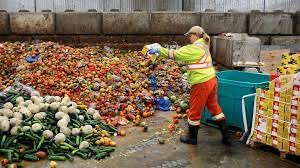
Another part of the same article, for reasons I do not claim to fathom, pointed to the mass of food waste in this country, some 4.5 million tonnes per year (√√ right unit used). Here's the relevant report. Now that is a lot, but reduces to 184 grams per person per day. I suggest that this is still a lot, but would perhaps equate to throwing away a couple of apples each, every day. I think we might throw that amount between us in a week, some 10-15 times less. Trying to find what proportion of this is deliberate, the bits declared inedible are estimated at 30%. Which still leaves some 3 million tonnes every year implied as being avoidable household food waste. The WRAP report is clear that the majority of waste is at the household level and it is this specific waste that is the 4.5 million tonnes. [Data for household also includes waste to sewer, which is not currently available for other sectors. This means that there is a component of unknown magnitude included in household and not included elsewhere - that could invalidate the comparison!]
There's a lot of detail in the report and it is clearly a serious attempt to provide trustable information at a level that might direct the nation into better action. I found a table showing that matters have improved [2007 vs 2018, Table 2, P8] by 15-20%. That is not at all implying that this is enough improvement, just that improvement has occurred. Redistribution (whatever that is, report) ) doubled between 2015 and 2018 and I doubt that this reduced across 2020 given what else was happening. ¹
The target here, called Courtauld 2025, is a food waste target that would result in a 40% reduction of wasted food by 2025 compared to 2007, against a target for a 50% reduction by 2030. A 50% reduction in UK wasted food (excluding inedible parts) per capita by 2030 compared to 2007 would equate to a reduction from 132 kg per person to 66 kg per person. Taking into consideration population growth, this would mean a reduction in food going to waste of around 3.5 Mt a year (2007 levels were 8.2 Mt [11.2 including inedible parts], and in 2030 they would be 4.6 Mt [8.1 Mt including inedible parts]).
Appendix 1 lists 'useful facts', though I'm afraid I read some of these with scepticism. Items 11 and 12 hit hard.
- WRAP research shows we now (2018) throw away 6.6 million tonnes of household food waste a year in the UK, compared to 8.1 million tonnes in 2007.
- Of the 6.6 million tonnes we throw away, almost three quarters (70% of the total) is food we could have eaten (4.5 million tonnes).
- Household food waste would fill approximately 66,000 three-bed terraced houses, equivalent to the population of a town the size of Peterborough.
- By 2018 UK household food waste had reduced by around 18% (1.4 million tonnes) a year compared to 2007.
- By 2018 food that could have been eaten (the ‘edible parts’) had reduced by 26% (1.6 million tonnes from 6.1 million tonnes to 4.5 million tonnes) a year compared to 2007.[The amount of inedible parts increased by ca 0.2 million tonnes by 2018 compared to 2007, in line with the increasing population; explaining why total food waste ‘only’ reduced by 1.4 million tonnes]
- The amount of food ‘saved’ (i.e. not wasted in 2018 compared to 2007) annually by 2018 would fill 3 Wembley stadia, 30 Royal Albert Halls, 13 million large wheelie bins (240l), 1,300 Olympic swimming pools or 170,000 bin lorries/dustcarts.
- Had the reduction in wasted food & drink (the edible parts; i.e. the 4.5 million tonnes) not occurred, consumers would have been spending £4.8 billion a year more (in 2018 compared to 2007) on food & drink bought but thrown away.
- The savings associated with the reduction in food that could have been eaten (the 4.5 million tonnes) amount to around 5.3 million tonnes of CO2e a year (in 2018 compared to 2007) (the same as taking 2.4 million cars off the road for a year).
- Around 70% of UK food we throw away (post farm gate) still comes from the home (i.e. of the total from manufacturing / processing, retail, hospitality and food service and homes (9.5 million tonnes), approximately 70% comes from homes (6.6 million tonnes).
- Food that could have been eaten but gets thrown away (4.5 million tonnes) is worth around £14 billion (£13.8 billion). This is around £60 per month for the average family with children. The carbon associated with this food is equivalent to that generated by one in five cars on UK roads.
- A UK household wastes on average the equivalent of eight meals a week. Based on 4.5 million tonnes of wasted food, 420g meal weight and 27,576,000 households
- An area almost the size of Wales (ca. 19,000km), would be needed to produce the food and drink currently wasted
¹ Redistribution of waste food is what happens when food that would otherwise have been thrown away is instead made available for people to eat. Example redistributor.